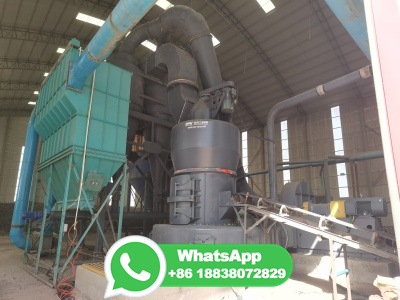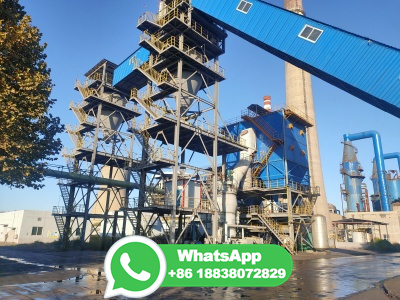
Processes for beneficiating coal are varied, but commonly utilize dense medium separation, jigs, or froth flotation to separate clean coal from noncoal material. Because of its versatility, high efficiency and ease of operation, dense medium separation is perhaps the preferred separation technique.
WhatsApp: +86 18203695377
At present, coal cleaning is accomplished through physical separation of particles low in mineral content from particles high in mineral content. In the future it may include chemical and biological treatment for removal of certain impurities from coal.
WhatsApp: +86 18203695377
Coal preparation, which may also be called washing, cleaning or processing, is the methodology by which coal feedstocks are upgraded in order to reduce freight costs, improve utilization properties and minimize environmental impacts.
WhatsApp: +86 18203695377
The life cycle environmental impacts of widely used fluegas cleaning processes, including limestonegypsum wet fluegas desulfurization (FGD), selective catalytic reduction denitration (SCR) and electrostatic precipitators (ESP), are compared. The abbreviations FGD, SCR and ESP in this article refer in particular to the above listed processes.
WhatsApp: +86 18203695377
In particular, the process of coal gasification (CG) subsystem, which is one of the primary coal clean and efficient utilization techniques (Lv et al., 2023), emits significant amounts of CO 2 due to the necessity of adjusting the H/C ratio of syngas via the watergas shift (WGS) unit (Chen et al., 2018).
WhatsApp: +86 18203695377
Evaluation of Coal Cleaning Processes and Techniques for Removing Pyritic Sulfur from Fine Coal and a great selection of related books, art and collectibles available now at
WhatsApp: +86 18203695377
A number of chemical coal cleaning processes have been investigated. These processes are quite varied with respect to the chemical reactions involved, operating conditions employed, effect on coal properties, byproducts and wastes produced, and results achieved. Most of the processes will remove 90% or more of the inorganic forms of sulfur ...
WhatsApp: +86 18203695377
The elements of a surface mining operation are (1) topsoil removal and storage for later use, (2) drilling and blasting the strata overlying the coal seam, (3) loading and transporting this fragmented overburden material (called spoil), (4) drilling and blasting the coal seam, (5) loading and transporting the coal, (6) backfilling with spoil and...
WhatsApp: +86 18203695377
Coal liquefaction is a process of converting coal into liquid hydrocarbons: liquid fuels and process is often known as "Coal to X" or "Carbon to X", where X can be many different hydrocarbonbased products. However, the most common process chain is "Coal to Liquid Fuels" (CTL).
WhatsApp: +86 18203695377
Those of interest to coal cleaning processes (total suspended particulates, sulfur oxides, and nitrogen oxides) arise from stationary sources and are generated mainly from coal combustion. Current national ambient air quality standards for the criteria pollutants are summarized in Table 35. ...
WhatsApp: +86 18203695377
Evaluation of Coal Cleaning Processes and Techniques for Removing Pyritic Sulfur from Fine Coal ISBN 10: ISBN 13: Bibliogov 2013 Softcover
WhatsApp: +86 18203695377
Coal cleaning methods are often categorized by the coal size range for which they are designed, that is, coarse, small, fine, and ultrafine coal. These terms can cause confusion because many of the principal methods and much of the equipment used for cleaning coal have significant overlap in the particle size ranges they can treat. Commonly ...
WhatsApp: +86 18203695377
With the advantages of its fast speed, effective and moderate controllable conditions, desulfurization of coal by microwave has become research focus in the field of clean coal technology. Coal is a homogeneous mixture which consists of various components with different dielectric properties, so their abilities to absorb microwaves are different, and the sulfurcontaining components are better ...
WhatsApp: +86 18203695377
Clean, or pure coal, is produced after coal washing where all other materials are removed. Coal cleaning processes/coal washing can be either physical (mechanical) or chemical cleaning which produces refined coal. Physical coal cleaning processes: the mechanical removal of coal contaminants using differences in density are the most common ...
WhatsApp: +86 18203695377
The diesel system will use a CWS produced from Ohio coal by a twostage coal cleaning and slurrying process. Another CCT program is demonstrating the combustion of injected coal in the tuyeres of two blast furnaces at Bethlehem Steel. Blast furnace coal injection technology, where granulated or pulverized coal is injected into a blast furnace ...
WhatsApp: +86 18203695377
The cleaning process consists of a number of steps that results in a product that is specifically suited to the needs of particular consumers. Among the earliest of these steps is crushing and sizing, two processes that reduce the coal to a form required by the consumer. The next step in coal preparation is a washing or cleaning step.
WhatsApp: +86 18203695377
Oxycoal combustion is one of the technical solutions for mitigating CO 2 in thermal power plants. For designing a technically viable and economically effective CO 2 capture process, effects by coals and configurations of flue gas cleaning steps are of importance. In this paper, characterization of the flue gas recycle (FGR) is conducted for an oxycoal combustion process.
WhatsApp: +86 18203695377
The coal cleaning environmental assessment program has as its specific objectives the evaluation of pollution control problems which are unique to coal preparation, storage and transportation. The coal preparation industry is a mature, yet changing industry and in recent years significant achieve ments have been made in pollution abatement.
WhatsApp: +86 18203695377
23. Estimated clean coal losses in froth flotation plants 57 24. Weighted average results for coarse coal/heavymedium and fine coalwashing processes (weighting factor = throughput rates based on installed capacity) 59 25. Summary of clean coal losses in washery reject (197880) 60 26.
WhatsApp: +86 18203695377
What Is Coal Preparation? • Coal preparation is the removal of undesirable material from the RunofMine (ROM) coal by employing separation processes which are able to differentiate between the physical and surface properties of the coal and the impurities. Through coal preparation, a uniform product is achieved.
WhatsApp: +86 18203695377
Coal Pollution Mitigation, sometimes also known as Clean Coal, is a series of systems and technologies that seek to mitigate (reduce harmful or unpleasant chemicals) health and environmental impact of coal; in particular air pollution from coalfired power stations, and from coal burnt by heavy industry. Clean Coal primarily focuses on removing ...
WhatsApp: +86 18203695377
The Coal Recovery and Cleaning by Flotation Flowsheet Diagram The above flowsheets are based on existing small coal flotation plants. They illustrate clearly the simplicity and feasibility of adding "SubA" Coal Flotation as an additional process to small washing plants.
WhatsApp: +86 18203695377
Corona electrostatic separation can remove inorganic materials from coal, reduce coal ash content and sulfur content and improve coal quality, reduce air pollution caused by smoke dust, SOX, and COX. The performance of corona electrostatic separation technology in cleaning a middle ash mediumash, highsulfur coal was experimentally investigated. The electrode voltage, drum rotational speed ...
WhatsApp: +86 18203695377
Types of Coal. The process by which something changes under the effect of pressure and temperature is known as metamorphism in geology. Coal is classified into different types based on the different stages of metamorphism undergone by it. ... In the, anthracite, which is the best grade of coal clean and smokeless replaced wood as a ...
WhatsApp: +86 18203695377
Microwave coal processing is a diverse area, which has the potential to aid in coal upgrading, cleaning and comminution, thus improving efficiency and reducing harmful emissions of coal usage.
WhatsApp: +86 18203695377
Coal preparation occurs in three stages: 1 crushing and sizing, or basic cleaning; (2) hydraulic separation, or standard cleaning; and (3) dense (heavy)medium separation, or complete cleaning. Flotation is an additional process that is increasingly being used during thirdstage cleaning to increase recovery and cleaning of fine coal.
WhatsApp: +86 18203695377
Low density material is clean coal while high density material is reject rock. Coal washing is accomplished by one of two major processes, by density separation or by froth flotation. Both processes depend on the fact that the particles of which a coal sample are made have different densities. When water is added to the sample, particles sink ...
WhatsApp: +86 18203695377
it is necessary to apply advanced coal cleaning methods which are still undergoing development. In the future, cleaning and preparing feedstocks should benefit various coal gasification and liquefaction processes. Removing part of the sulfur and mineral matter from the feedstock reduces the load of impurities which has to be handled
WhatsApp: +86 18203695377
The analysis of methods for reducing overall environmental pollution through the use of cleaned coal involves mathematical and modeling techniques used for identification of optimum coal cleaning process configurations, pollution control equipment, and waste manage ment techniques.
WhatsApp: +86 18203695377
Sulfur removal by fine coal cleaning processes. Investigations were carried out as part of a collaborative project to develop a commercialscale fine coal cleaning process to remove pyritic sulfur. Wet processes, particularly for ultrafine (< mm) material, were studied. Initially the suitability of some commercially available enhanced ...
WhatsApp: +86 18203695377
Wet scrubbers, or flue gas desulfurization systems, remove sulfur dioxide, a major cause of acid rain, by spraying flue gas with limestone and water. The mixture reacts with the sulfur dioxide to form synthetic gypsum, a component of drywall.
WhatsApp: +86 18203695377